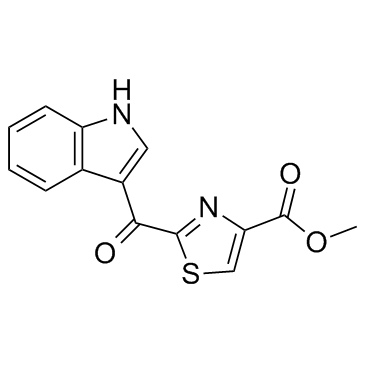| Description |
ITE is a potent endogenous agonist of aryl hydrocarbon receptor (AhR), binding directly to AHR, with a Ki of 3 nM. ITE also has immunosuppressive activity.
|
| Related Catalog |
|
| Target |
Ki: 3 nM (AhR)[1]
|
| In Vitro |
ITE is an endogenous agonist of AhR, binding directly to AHR, with a Ki of 3 nM[1]. ITE (0.03-30 mg/mL) decreases the antigen-specific T-cell proliferative responses[2]. ITE potently inhibits human pulmonary artery endothelial (HPAECs) growth at 10 and 20 µM, but shows no effect at 0.01-5 µM. ITE does not affect cell cycle progress of HPAECs at 10 and 20 µM, or induce expression of cleaved caspase-3 protein in HPAECs at 20 µM. In addition, ITE (20 µM) elevates CYP1A1 and CYP1B1 mRNA levels and decreases the levels of AhR protein in HPAECs[3].
|
| In Vivo |
ITE (200 μg, i.p.) significantly suppresses the development of experimental autoimmune uveitis (EAU) in mice. ITE reduces the proportions of cells expressing IFN-γ, IL-17, or IL-10 in mice. ITE also suppresses the secretion of inflammatory cytokines by LN cells in mice[2].
|
| Cell Assay |
Subconfluent cells (25, 000 cells/well) are seeded in 96-well plates. Cells are treated with ITE at 5, 10 and 20 µM or DMSO (0.1% v/v) in ECM for 2, 4 or 6 days with a change of ECM containing DMSO or ITE every other day (5 wells/treatment). At the end of treatment, cells are incubated with MTT reagent for 4 hr, and solubilized in crystal dissolving solution (100 µL/well) for 20 min. The absorbance is determined at 570 nm using the microplate reader[3].
|
| Animal Admin |
Mice[2] Eight- to 12-week-old female B10.A mice is used in the assay. Daily treatment starts on day 0 and consists of 200 μg of ITE suspended in 0.2 mL PBS, given intraperitoneally. Control mice are similarly treated with 0.2 mL of the vehicle, PBS containing 3.6% DMSO[2].
|
| References |
[1]. Song J, et al. A ligand for the aryl hydrocarbon receptor isolated from lung. Proc Natl Acad Sci U S A. 2002 Nov 12;99(23):14694-9. [2]. Nugent LF, et al. ITE, a novel endogenous nontoxic aryl hydrocarbon receptor ligand, efficiently suppresses EAU and T-cell-mediated immunity. Invest Ophthalmol Vis Sci. 2013 Nov 13;54(12):7463-9. [3]. Pang LP, et al. ITE inhibits growth of human pulmonary artery endothelial cells. Exp Lung Res. 2017 Oct;43(8):283-292.
|


